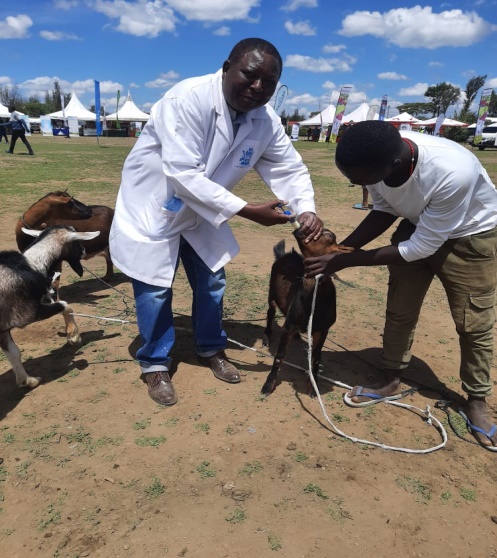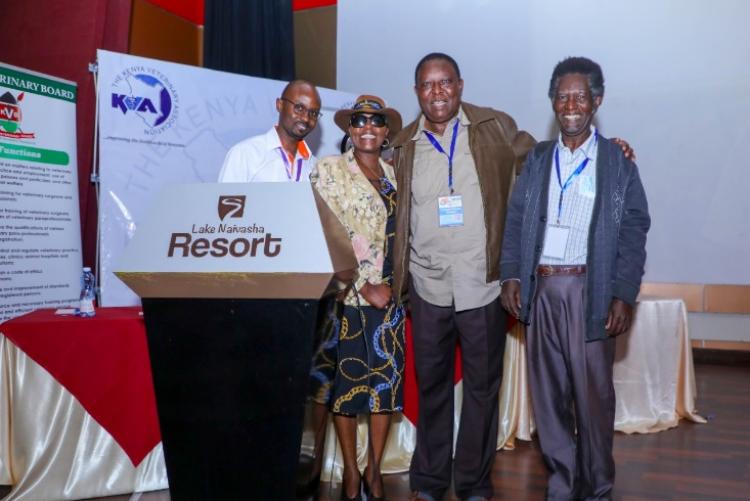56TH KVA ANNUAL SCIENTIFIC CONFERENCE
Dr. R.M. Waruiru attended and participated the 56th KVA annual scientific conference held at Lake Naivasha Resort, Nakuru County, Kenya, April 27th – 29th 2022.
He presented the following journal articles;
1. Pathology of Goats Feeding on Opuntia stricta in Laikipia County, Kenya
Ncebere J.M., Waruiru R.M., Mbuthia P.G. and Gathumbi P.K.
Abstract
Opuntia stricta, a plant with thorns and spines has invaded northern part of Laikipia County, Kenya and reduced prime grazing land and pastures. Its cladodes and fruits are protected by thorns and small spines called glochids. Goats and other livestock species feed on the ripened spiny fruits of O. stricta. In the process glochids attach and penetrate the lips, buccal cavity, stomach and intestines of the animals and initiate abscess development at injured sites. Consequently, animals become emaciated, drop milk yield, become blind and then die. A study was conducted from October 2018 to February 2019 to determine the pathology in goats feeding on this plant in Laikipia North Sub-county. Twenty four goats were purchased for the study. Eighteen goats whose health was affected by feeding on the plant (sick goats) were purchased from three locations that were invaded by this cactus. Six goats that were clinically healthy (controls) were purchased from two O. stricta - free ranches in the study area. The study goats were clinically examined for lesions and euthanized for post mortem examination. Clinically, O. stricta affected goats had poor body condition, wounds on various body parts and diarrhea. Variable numbers of O. stricta spines occurred externally on the skin throughout the body and elicited pain, swelling, and ulcerative wounds on affected parts. Internal lesions were observed in subcutaneous tissues (100%), together with stomatitis, cheilitis, gingivitis, glossitis, abomasitis (100%), rumen, reticulum, omasum thinning and loss of papillae (72.2%); esophagitis and duodenitis (5.6%). Carcasses had gelatinous fat and muscular atrophy. Other gross lesions were generalized viscera atrophy, edema, subcutaneous emphysema, lymphadenopathy, abscesses, ascites, hydrothorax and hydropericardium. Abomasal wall and mucosal folds were swollen with edema, haemorrhages, and scattered abscesses. Histopathology confirmed the main lesions in all affected goats were foreign body granulomas which were located in all organs with gross lesions. Goats from O. stricta –free ranches had no spines or lesions. Emaciation of the sick goats was attributed to malnutrition caused by reduced feed intake due to severe injuries by O. stricta spines in the gastrointestinal tract. Pathological lesions caused by O. stricta resulted to death of animals and frequent condemnations of whole carcasses and organs at slaughter. Measures to control this invasive plant should be instituted in order to minimize losses in livestock production and the associated impacts on lives and livelihoods of people in Laikipia County.
Keywords: Emaciation, goats, lesions, Opuntia stricta, pathology, spines.
2. Prevalence, Etiology and Risk Factors Associated with Occurrence of Cutaneous Myiasis of Small Animals in Kenya Kamuti N.M., Waruiru R.M., Kandagor A.K., Mbuthia P.G. and Githigia S.M.
Abstract
A cross-sectional study of cutaneous myiasis (CM) of dogs and cats was conducted in two counties of Kenya from March to August, 2021 (Kitui County) and October to November 2021 (Kwale County), respectively. The objective of the study was to determine the prevalence, risk factors and the etiology of CM in pets in the two counties. Face to face questionnaire interviews were conducted for assessment of risk factors associated with occurrence of canine cutaneous myiasis (CCM) in Kitui County. A total of 450 (Kitui, 400; Kwale, 50) dogs and 10 cats (Kwale County) were physically examined for the presence of skin lesions characteristic of CM. At least two larvae were collected from each infected dog/cat by application of digital pressure at the base of the skin lesions. These were preserved in 70% ethanol, transported to the laboratory for characterization and identification. Overall prevalence of CCM was 45% (180/400) and 12% (6/50) in Kitui and Kwale counties, respectively. Twenty percent (2/10) of cats sampled in Kwale County had characteristic furuncular lesions associated with feline cutaneous myiasis (FCM). Freshly harvested C. anthropophaga larvae were cultured for four weeks and adult flies hatched, captured and identified. Analysis of questionnaires using chi-square revealed that there was a statistically significant association among different dog breeds in both counties and myiasis (p˂0.05) with local mongrels having a higher prevalence (Kitui, 47.5%; Kwale, 83.3%) relative to pure breeds (Kitui, 8%; Kwale, 16.7%). However, there was no statistically significant differences in prevalence of CCM among different dog age and sex groups (p>0.05) in both counties. Only adult female (28.6%) cats had FCM in Kwale County (p<0.05). All dipteran maggots sampled from furuncular lesions were identified as Cordylobia anthropophaga larvae and hatched adult flies were ʻʻtumbu flies” and, were the etiological agents of CM of dogs and cats in the two counties. Lack of housing, housing structures; and dog living area environmental hygiene were the main risk factors associated with occurrence of CCM (p<0.05) in Kitui County. Further studies on seasonal prevalence, public health importance and control strategies of CM in animals including humans are recommended.
Keywords: Cats, Cordylobia anthropophaga, Dogs, Furuncular myiasis, Prevalence.
C: 2022 World Veterinary Day
Attended and participated in the World Veterinary Day held at Karagita grounds in Naivasha,
Nakuru County, Kenya on Saturday April 30th 2022.


- Log in to post comments

